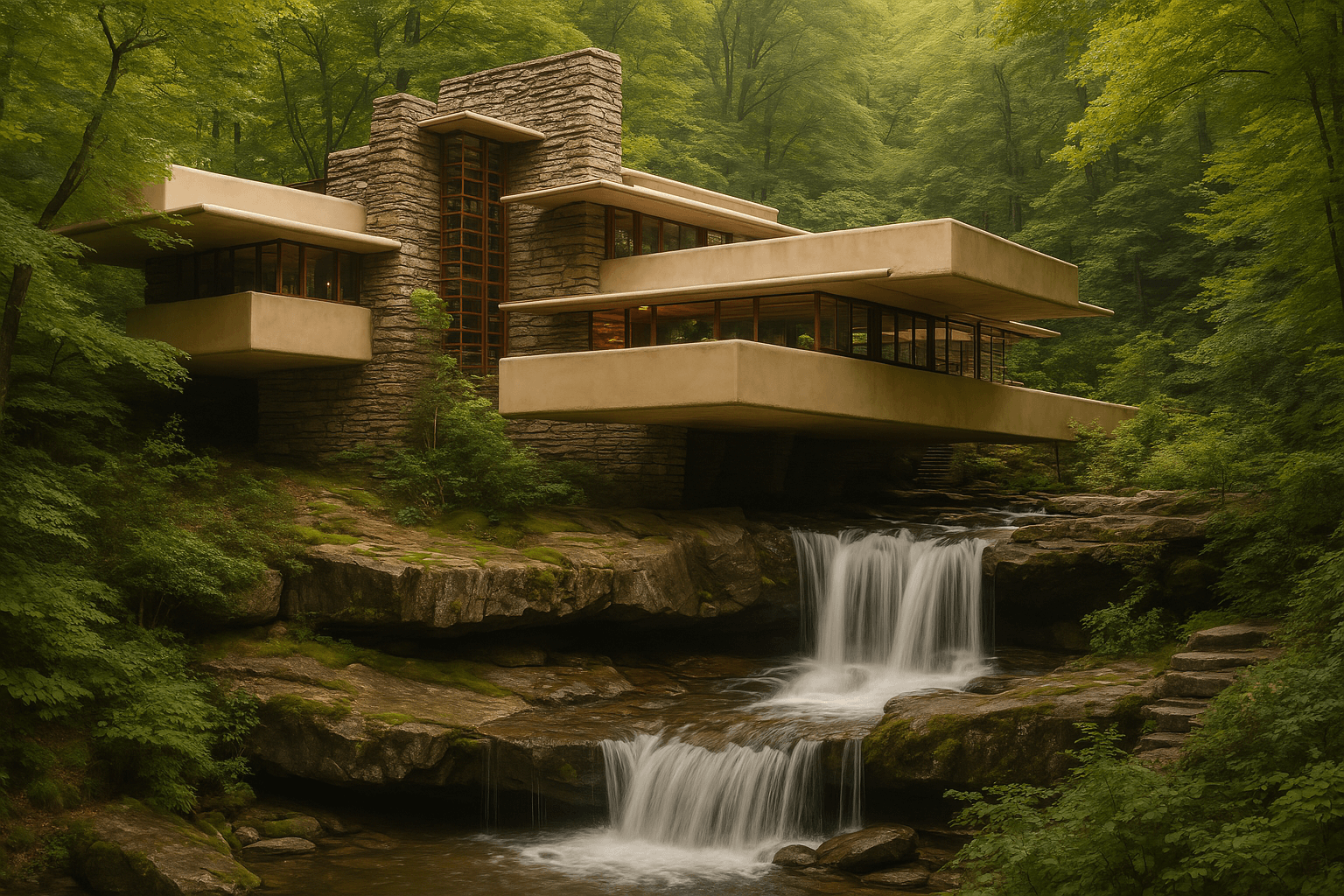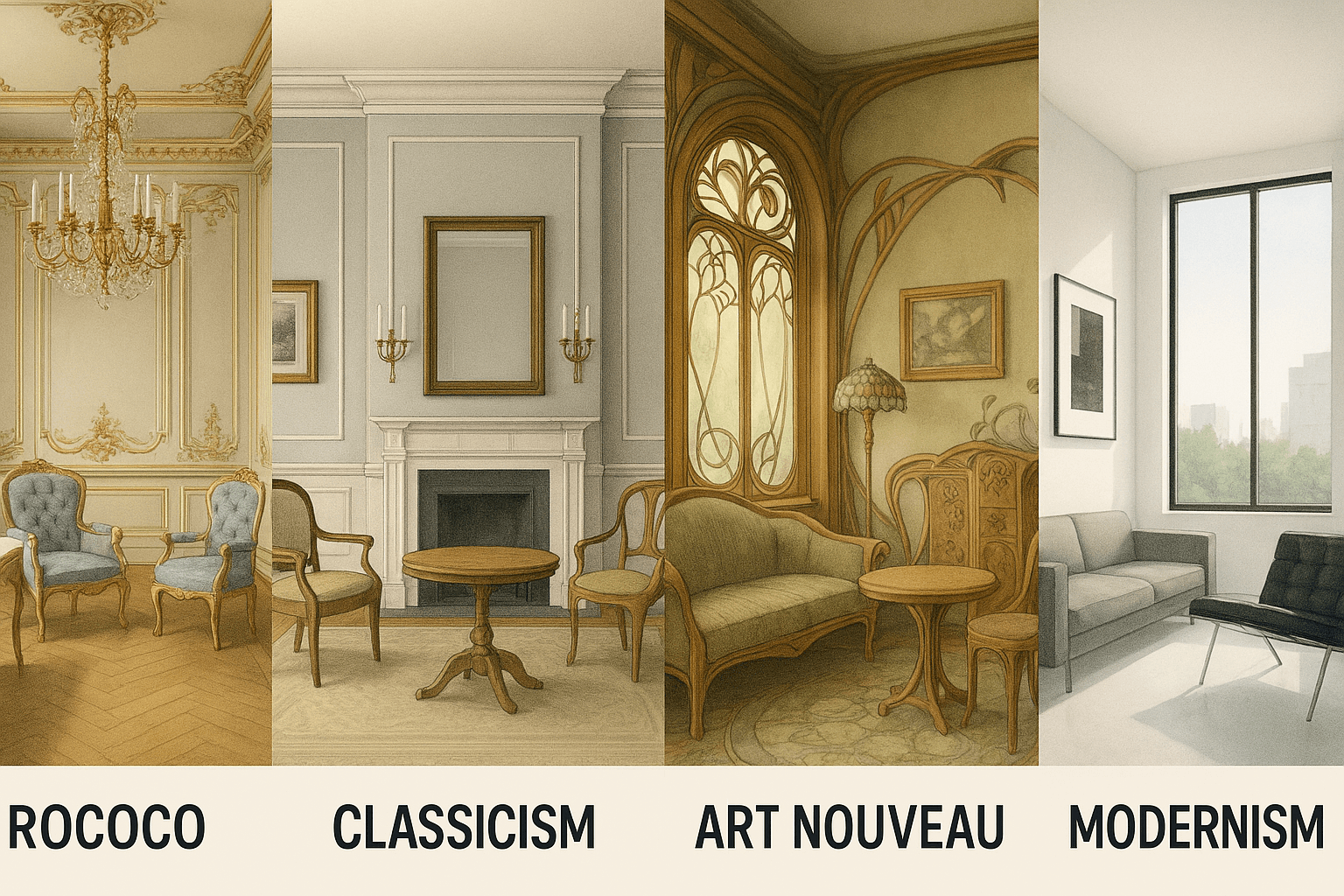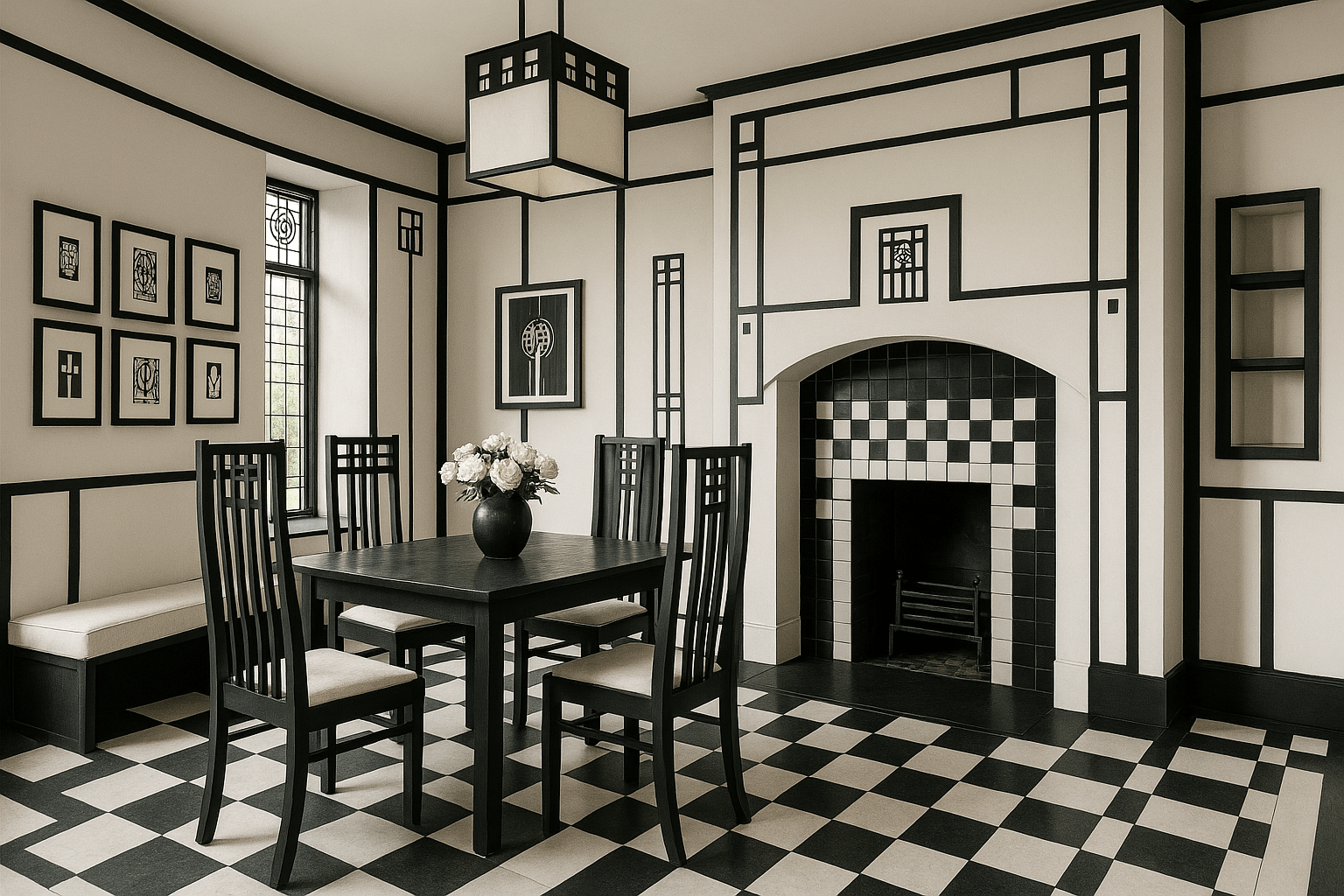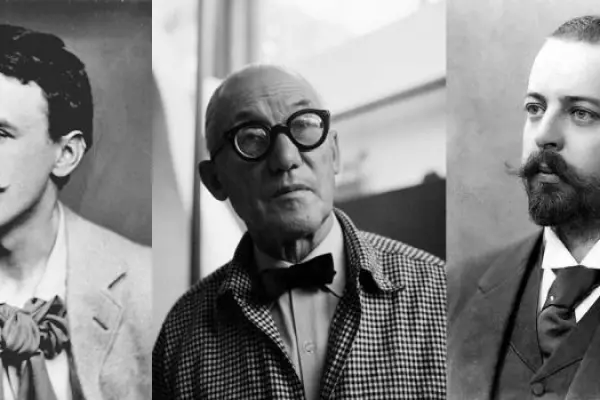The history of interior design and the architects who created its foundation are inextricably linked. Famous architects and interior design evolved together, reflecting the transformations of society. Imagine what it's like to enter a room where every detail has been thoughtfully designed by a brilliant mind, where the space literally envelops you with its harmony! The relationship between architecture and interior design has been shaped over centuries through the ideas of pioneers of modern interior design. In this article, we will examine nine outstanding individuals whose architectural principles in interior design have had a revolutionary impact on the development of this art form.
"Interior is the natural extension of architecture. There cannot be a division between architecture, interior, and design objects. They must form a unified whole, reflecting the philosophy of their creator." – Frank Lloyd Wright
Evolution of Spatial Concepts Through the Legacy of Great Masters
 Influential architects in interior design have formed various styles and directions, creating a rich legacy for future generations. Architects who changed interior design implemented concepts that transformed the perception of living space. Interior styles of famous architects have come a long way from classical forms to modernist concepts. The transformation of architectural ideas in interiors occurred due to the innovative thinking of designers from different eras. The philosophy of space in interior design has been formed over centuries, creating entire schools and directions.
Influential architects in interior design have formed various styles and directions, creating a rich legacy for future generations. Architects who changed interior design implemented concepts that transformed the perception of living space. Interior styles of famous architects have come a long way from classical forms to modernist concepts. The transformation of architectural ideas in interiors occurred due to the innovative thinking of designers from different eras. The philosophy of space in interior design has been formed over centuries, creating entire schools and directions.
Let's consider how the psychology of architectural interior perception changed with the development of styles:
- Classicism (Quarenghi) — interiors based on symmetry and harmony create a sense of order and stability
- Modernism in interior design (Le Corbusier) — open spaces and functionality shape the modern perception of freedom
- Minimalism and famous architects (Mies van der Rohe) — "less is more," focus on the essential
- Organic architecture in interiors (Wright) — integration with surroundings creates a special sense of security
- Art Deco and Art Nouveau in interiors (Mackintosh) — decorative elements and aesthetics as the basis of emotional perception
The key architectural schools that emerged under the influence of these principles continue to shape modern interior design. The influence of the Bauhaus school and its interior design philosophy, founded by Walter Gropius, is especially significant. It promoted the ideas of functionalism and the integration of art with technology in architectural work. The 20th century marked a revolution in interior design that began precisely with these schools, which changed the paradigm of spatial aesthetics.

| Architect | Period | Style | Key Interior Features | Influence on Modern Design |
|---|---|---|---|---|
| Germain Boffrand | 1667-1754 | Rococo | Elegant ornamentation, asymmetry, pastel tones | Decorative elements in classical interiors |
| Antonio Rinaldi | 1710-1794 | Rococo | Refined finishing, abundance of details, harmony | Integration of architecture and decor |
| Giacomo Quarenghi | 1744-1817 | Classicism | Symmetry, monumentality, antique motifs | Concepts of proportionality in space |
| Domenico Gilardi | 1785-1845 | Empire | Imperial style, noble materials, grandeur | Elements of luxury in modern interiors |
| Fyodor Shekhtel | 1859-1926 | Art Nouveau/Secession | Organic forms, natural motifs, unity of style | Holistic approach to space design |
| Charles Rennie Mackintosh | 1868-1928 | Art Nouveau/Modern | Geometric shapes, functionality, black and white palette | Minimalism and functionalism in architects' works |
| Le Corbusier | 1887-1965 | Modernism/Purism | Open spaces, simplicity, ergonomics | Concept of a "machine for living," modular systems |
| Dorothy May Kinnicutt | 1910-1991 | "Patchwork Style" | Bright color scheme, eclecticism, mixing textures | Personalization and individuality in interiors |
| Frank Lloyd Wright | 1867-1959 | Organic Architecture | Unity with nature, open floor plans, lighting | Concept of total design, built-in furniture |
This table demonstrates the diversity of approaches and interior styles created by great architects in design history. Each master introduced unique elements that became the foundation for further development of interior design and formed entire directions in the profession.
Germain Boffrand and the Birth of Rococo in Interior Design
French architect Germain Boffrand (1667-1754) is considered the creator of the Rococo style, which revolutionized interior design in the 18th century. The 19th century: the beginning of architectural influence on interiors can be traced precisely to his works. Boffrand created interiors where architectural concepts harmoniously combined with decorative elements.
The Rococo style in Boffrand's interiors was characterized by lightness, playfulness, and airiness, which was the opposite of heavy Baroque. Innovative architects in design, like Boffrand, created spaces where architectural elements and decor formed a single harmonious whole, influencing the perception of the room and creating an atmosphere of exquisite refinement.
Antonio Rinaldi: Rococo in Russia
Italian architect Antonio Rinaldi (1710-1794) brought the Rococo style to Russian architecture and interior design. His works in Oranienbaum and Tsarskoye Selo demonstrate virtuoso mastery of form and space, creating interiors that astonish with their richness of finish and harmony of proportions.
Rinaldi masterfully used color and light in his interiors, creating unique spaces that are still considered masterpieces of interior art today. His approach to space organization and attention to detail had a significant influence on the development of the Russian school of architectural interior design. Where can one see interiors of great architects? Rinaldi's works have been preserved in palace complexes of St. Petersburg and its suburbs, many of which are open to visitors at exhibitions and museums of interior design.
Giacomo Quarenghi and Classicism in Interior Design
Italian master Giacomo Quarenghi (1744-1817) was a representative of mature Classicism, whose projects made a significant contribution to the development of interior design. His works in St. Petersburg are distinguished by monumentality, harmony of proportions, and strict symmetry – principles that are still relevant in modern interior design.
Quarenghi strived to create holistic spaces where architecture, decor, and function form a single harmonious whole. Isn't it breathtaking to think that his perfect proportions still make our hearts beat faster when we enter the halls he designed? His approach to interior design was based on the philosophy of space in interior design and the pursuit of ideal proportions, which significantly influenced the development of classical style in interiors. For an in-depth analysis of Quarenghi's works and their influence on modern interiors, we recommend referring to the research «Architectural Classicism Versus Modernism: Ethic or Aesthetic?», which reveals the relationship between emotional perception and classical architecture.
"Space should speak the language of proportions and harmony. When you enter a properly designed room, you feel its rhythm and proportionality to humans – this is the essence of interior art." – a principle that guided Giacomo Quarenghi in his projects
Domenico Gilardi and the Empire Style in Interiors
Italian architect Domenico Gilardi (1785-1845) is known for his mastery in creating interiors in the Empire style, which continues to inspire many designers today. His work on the restoration of Moscow after the fire of 1812 allowed for the creation of unique interiors that combine imperial solemnity with functionality and comfort.
Gilardi's interiors are characterized by monumentality, the use of antique motifs and symbols of power, richness of finish, and the application of expensive materials. This style of imperial grandeur has transformed in our days into elegant classical interiors with elements of luxury and status. For those interested in how to apply the principles of famous architects in their home, the Empire style can be adapted in the form of individual decor elements and accents in modern interiors.
Fyodor Shekhtel and Art Nouveau in Interior Design
Russian architect Fyodor Shekhtel (1859-1926) became one of the key figures in the development of Art Nouveau and Secession in Russia. Innovative architects in design, like Shekhtel, transformed the approach to interior design, creating holistic spaces where each element had meaning.
In Shekhtel's interiors, one can trace the influence of organic architecture – flowing lines, natural motifs, functionality, and ergonomics. His works for Moscow mansions demonstrate masterful command of space and light, creating a unique atmosphere characteristic of the Art Nouveau style. Shekhtel created interiors where anthropometry and ergonomics in architectural interiors were considered on par with aesthetic qualities.
Charles Rennie Mackintosh: Art Nouveau Innovations in Interior Design
 Scottish architect and artist Charles Rennie Mackintosh (1868-1928) is considered the founder of Art Nouveau principles and one of the pioneers of modern interior design. His unique approach to space design, combining geometric shapes with organic forms, created a recognizable style whose influence spread far beyond Great Britain. Charles Rennie Mackintosh's Art Nouveau became a separate direction in the history of interior design.
Scottish architect and artist Charles Rennie Mackintosh (1868-1928) is considered the founder of Art Nouveau principles and one of the pioneers of modern interior design. His unique approach to space design, combining geometric shapes with organic forms, created a recognizable style whose influence spread far beyond Great Britain. Charles Rennie Mackintosh's Art Nouveau became a separate direction in the history of interior design.
Mackintosh was a proponent of the concept of total design, creating spaces where every element – from the building structure to furniture and lighting – was developed as part of a unified whole. His famous Tea Room in Glasgow demonstrates these principles, combining functionality with the aesthetics of minimalism and geometric forms.
Features of Mackintosh's Interiors:
- Contrasting combinations of black and white with accents of pink and green
- Elongated vertical lines creating a sense of upward aspiration
- Geometric patterns and stylized plant motifs
- Integration of all interior elements into a unified artistic concept
- Special attention to details and quality of execution of each element
Modern design studios in the style of famous architects, such as Glasgow Design Studio and Studio Rennie, continue Mackintosh's traditions, adapting his principles to modern interiors. His ideas are especially in demand when designing boutique hotels, art spaces, and creative offices, where individual approach and artistic integrity are valued. Nowadays, books about architects and interior design are available, providing detailed analysis of Mackintosh's legacy.
Le Corbusier: The Modernism Revolution in Interior Design
French architect and theorist Le Corbusier (1887-1965) had an enormous influence on architectural styles and interior design of the 20th century. Le Corbusier and interior design is a story about how functionalism and rationalism changed the perception of living space. His concept of a "machine for living" and five principles of architecture transformed the approach to organizing living space, introducing open floor plans, functionality, and ergonomics as key elements of design.
The peculiarity of Le Corbusier's interiors lies in the principle of "free plan" – an open space not divided by load-bearing walls, which allows for the creation of flexible and adaptive interiors. Surprisingly, even after almost a century, entering a space designed by him, you feel awe and admiration – his ideas feel so modern and timeless! His modular proportion system "Modulor," based on anthropometry and ergonomics in architectural interiors, still influences the design of spaces with consideration for human scale.
Success Story: Villa Savoye and the Revolution in Living Space
 The project of Villa Savoye in Poissy (1928-1931) became a manifesto of Le Corbusier's ideas in the field of interior design. The house, built on pilotis, with ribbon windows, free planning, and a roof garden, demonstrated a fundamentally new approach to organizing living space. The interior of the villa was a single flowing space where functional zones smoothly transitioned into one another without clear boundaries. Furniture was placed freely, not attached to walls, creating a sense of spaciousness and freedom. This project became a turning point in the history of interior design, showing the possibilities of open planning and a minimalist approach to designing living space. Today, the principles established in Villa Savoye are used in most modern residential interiors – from city apartments to country houses.
The project of Villa Savoye in Poissy (1928-1931) became a manifesto of Le Corbusier's ideas in the field of interior design. The house, built on pilotis, with ribbon windows, free planning, and a roof garden, demonstrated a fundamentally new approach to organizing living space. The interior of the villa was a single flowing space where functional zones smoothly transitioned into one another without clear boundaries. Furniture was placed freely, not attached to walls, creating a sense of spaciousness and freedom. This project became a turning point in the history of interior design, showing the possibilities of open planning and a minimalist approach to designing living space. Today, the principles established in Villa Savoye are used in most modern residential interiors – from city apartments to country houses.
Women Architects: Underappreciated Contribution to Interior Design
When speaking of influential architects in design history, it's important to note the significant but often underappreciated contribution of women. Dorothy May Kinnicutt is not the only woman whose ideas changed the perception of interior design.
Eileen Gray (1878-1976), an Irish designer and architect, created revolutionary minimalist interiors where functionalism in architects' works was combined with aesthetics. Her Villa E-1027 became a manifesto of modernism in interior design, demonstrating how space can be transformed through multifunctional furniture and carefully thought-out lighting.
Lilly Reich (1885-1947), a German architect and designer, worked closely with Ludwig Mies van der Rohe, whose furniture and interiors are considered benchmarks. Together they worked on the famous Barcelona Pavilion. Her innovative approach to exhibition design and interiors influenced an entire generation of designers.
Florence Knoll (1917-2019) revolutionized the design of commercial interiors by introducing the "office landscape" – an open space with modular furniture. Her concept of integrating architecture, furniture, and textiles into a unified system defined the appearance of modern office interiors.
These pioneers of female design not only overcame gender barriers of their time but also created principles that continue to influence modern interiors of residential and commercial spaces. Their works deserve to be studied in courses on the history of interior design.
Dorothy May Kinnicutt and the "Patchwork Style" in Interiors
The founder of the "patchwork style," Dorothy May Kinnicutt, was invited to create the interior of the White House, which demonstrates recognition of her contribution to the development of interior design. Her approach was based on bright color combinations, mixing textures and materials, creating individual and personalized spaces.
Kinnicutt advocated the idea that an interior should reflect the personality of its owner, rather than following rigid stylistic frameworks. This principle of individualizing living space has become one of the key principles in modern interior design, where personalization is considered the most important aspect of creating a comfortable home. Kinnicutt introduced an eclectic approach that became a precursor to postmodernism in interior design.
Frank Lloyd Wright: Organic Architecture in Interiors
American architect Frank Lloyd Wright (1867-1959) is known for his innovative approach to design and the concept of organic architecture, which envisions a harmonious coexistence of a building with its environment. Frank Lloyd Wright created interiors with special attention to detail and unity with nature. How did Frank Lloyd Wright influence interiors? He introduced open floor plans, integration of internal and external space, and developed systems of intelligent lighting.
"The interior is no longer an interior in the old sense of the word. Walls have now become merely a means to discipline space, not to separate you from it." – Frank Lloyd Wright, explaining his "open plan" concept
Wright was a pioneer of built-in furniture and lighting fixtures that became an organic part of architecture rather than separate elements. His approach to creating a holistic space where all elements are interconnected and harmoniously combined had an enormous influence on modern interior design and the concept of total design. It's impossible not to fall in love with Wright's interiors – they seem to embrace you with their thoughtfulness and naturalness, creating the feeling of an ideal home you've always dreamed of! As noted by Stuart Graff in his research «Organic Architecture and the Sustaining Ecosystem», Wright's ideas about organic architecture and unity with nature remain particularly relevant in the era of ecological design and sustainable development.
Modern Implementation of Wright's Principles: Practical Application
The ideas of Frank Lloyd Wright's organic architecture have not remained just historical heritage – they are actively embodied in modern interiors. Here's how his concepts can be applied in contemporary housing:
- Open Planning — combining living room, dining area, and kitchen into a single space devoid of excessive partitions
- Integration with Nature — panoramic windows overlooking a garden or natural landscape, winter gardens, use of natural materials
- Built-in Furniture — shelves, sofas, and storage systems integrated into the room's architecture
- Horizontal Lines — low ceilings in corridors transitioning to higher ones in living areas, long horizontal shelves emphasizing the horizon line
- Natural Lighting — a thoughtful system of windows, skylights, and light wells providing movement of light throughout the day
Studio "Wright Inspired Design" successfully applies these principles in modern urban apartments, achieving a balance between historical heritage and the demands of modern life. In consultations on interiors in the style of great architects, clients note a special sense of harmony and well-being created by interiors inspired by Wright's ideas.
Practical Story: Implementation of Le Corbusier's Principles in a Modern Apartment
Mikhail and Anna, a young family from Moscow, approached designer Ekaterina Smirnova with a request to transform their typical two-room apartment. "We wanted a space filled with light and air, without a feeling of confinement," recalls Anna.
Ekaterina proposed reorganizing the space based on Le Corbusier's five principles: removing load-bearing walls between rooms, creating a unified space for the living room and kitchen; organizing ribbon glazing, visually expanding the apartment's boundaries; raising functional zones on "pilotis" — platforms of different heights; freeing the roof — creating multi-level ceilings with integrated lighting; creating a free plan with mobile partitions instead of walls.
"When the work was completed, we literally didn't recognize our apartment," shares Mikhail. — "65 square meters transformed into a spacious, light-filled home. It's especially impressive how natural light penetrates into every corner of the apartment thanks to glass partitions and thoughtfully placed mirrors."
This example shows how principles formulated almost a century ago can transform modern living space, making it not only aesthetically pleasing but also functionally perfect.
Commercial Interiors: The Influence of Architectural Concepts on Business Spaces
The principles of great architects have found application not only in residential interiors but have also defined the appearance of modern commercial spaces. The transformation of architectural ideas in interiors from the residential environment to the business one has been occurring throughout the 20th century and continues now.
Office Spaces: From Cabinets to Open Floor Plans
Le Corbusier's concept of "free plan" revolutionized office space, leading to the emergence of open floor plans. Modern companies such as Apple and Google have developed these ideas, creating creative work environments where space stimulates collaboration and innovative thinking.
Minimalism and functionality, promoted by Mies van der Rohe, are reflected in modern business centers with their laconic interiors of glass, metal, and concrete. The "less is more" aesthetic has defined the style of corporate headquarters around the world, and high-tech in interiors has become a popular direction for office spaces.
Retail and Hospitality: Creating a Unique Experience
The concepts of total design by Mackintosh and Wright have transformed into the modern approach to designing boutiques and premium hotels. Each element – from architecture to door handles – is created as part of a unified concept that forms a holistic user experience.
Organic forms and connection with nature, which Alvar Aalto promoted (his Scandinavian interior design became world-renowned), are widely used in modern spa centers and wellness spaces, where design contributes to relaxation and recovery. Luis Barragán used color in interiors as an emotional tool, which is now applied in restaurants and hotels to create a certain mood.
Zaha Hadid introduced innovative design into the world of shopping centers and airport terminals, creating futuristic spaces with a unique atmosphere. Philippe Starck enriched modern interiors with a playful approach to design, blurring the boundaries between classics and avant-garde in hotels and restaurants.
Such transfer of architectural principles to commercial spaces not only creates an aesthetically pleasing environment but also contributes to achieving business goals: increasing employee productivity, boosting sales, or creating unforgettable impressions for clients.
Sustainable Design: Ecological Legacy of Great Architects
Many principles established by architectural pioneers turned out to be surprisingly in tune with modern concepts of ecology and sustainable development. Sustainable design in the legacy of great architects can be traced long before ecological issues became relevant.
Frank Lloyd Wright's organic architecture, with its attention to local landscape and materials, anticipated modern principles of biophilic design. His projects, harmoniously integrated into the environment, demonstrate an approach that minimizes negative impact on nature.
Alvar Aalto, a Finnish architect, used local wood and natural materials long before it became an ecological trend. His attention to natural lighting and ventilation resonates with modern standards of energy-efficient construction.
Zaha Hadid, despite the futuristic nature of her projects, implemented innovative technologies for creating energy-efficient buildings. Her parametric approach allowed optimizing the building's shape for natural air circulation and maximum use of daylight.
Tadao Ando creates minimalist interiors with special attention to natural elements such as light and water, achieving emotional impact with minimal means. His works demonstrate how contemplative spaces can be created without excesses, which corresponds to the principles of sustainable consumption.
Modern interior designers adapt these historical principles, integrating them with the latest technologies to create spaces that are not only aesthetically pleasing but also environmentally responsible. This demonstrates how the ideas of great architects continue to evolve, responding to the challenges of a new era.
Conclusion: The Legacy of Architects in Modern Interior Design
These nine great architects in design history have left an indelible mark on the development of interior design. Their influence on modern interiors is manifested in architectural concepts that we use today – from open floor plans and functionality to ergonomics and the aesthetics of minimalism.
Understanding the philosophy of space in interior design, which these innovators developed, helps modern designers create harmonious and functional interiors. Architects who changed interior design showed how to achieve a balance between beauty and practicality, traditions and innovations.
Today, modern followers of great architects continue to develop their ideas, adapting classical principles to new technologies and social needs. The evolution of interior design continues, but the foundation laid by industry pioneers remains relevant and inspiring for new generations of designers.
It is thanks to their creativity and talent that the history of interior design and architects have become inextricably linked, and interiors have transformed from simply functional spaces into works of art that reflect the era and culture of their time.
Recommended Literature for In-Depth Study
- Banham, R. (1996). Theory and Design in the First Machine Age. MIT Press.
- Curtis, W. J. R. (1996). Modern Architecture Since 1900. Phaidon Press.
- Frampton, K. (2007). Modern Architecture: A Critical History. Thames & Hudson.
- Giedion, S. (1967). Space, Time and Architecture. Harvard University Press.
- Hitchcock, H. R., & Johnson, P. (1997). The International Style. W. W. Norton & Company.
- Jencks, C. (2002). The New Paradigm in Architecture. Yale University Press.
- Pile, J. (2005). A History of Interior Design. Laurence King Publishing.
- Rybczynski, W. (2002). The Perfect House: A Journey with the Renaissance Master Andrea Palladio. Scribner.
- Sparke, P. (2010). The Modern Interior. Reaktion Books.
- Zevi, B. (1978). The Modern Language of Architecture. University of Washington Press.

